Spinach and Feta Pasta: a Simple Fusion of Flavor and Tradition
There’s a certain kind of magic that happens when cultures intertwine over shared meals. I still remember the day I learned to make Spinach and Feta Pasta. It was a lazy Sunday in Aix-en-Provence, France, where I was studying French literature. The streets buzzed with the scent of boulangeries and lavender, and I was nestled in the small kitchen of my Greek friend, Eleni. As we chopped garlic and crumbled feta, she told me how this simple, rustic dish had made its way from her grandmother’s village on the Aegean coast to her student apartment in France.
As a Tunisian woman with a deep love for travel, cooking has always been my passport to places my feet hadn’t yet touched. And when I returned home, this dish came with me. My own twist? A hint of Ras el Hanout (which I discovered from my Moroccan husband)for a Moroccan breeze in a Mediterranean recipe.
This article explores everything you need to know about Spinach and Feta Pasta: its origins, preparation techniques, variations, pairing options, and health aspects. Whether you’re a weeknight cook or a food enthusiast exploring Mediterranean flavors, you’re in for a flavorful journey.
Table Of Content

Spinach and Feta Pasta: a Simple Fusion of Flavor and Tradition
- Total Time: 25 minutes
- Yield: 2–3 servings
- Diet: Vegetarian
Description
A quick and flavorful Mediterranean-inspired spinach and feta pasta dish made with tender baby spinach, creamy crumbled feta, garlic, and olive oil. Perfect for a weeknight dinner, this recipe delivers bold flavor with minimal ingredients and effort.
Ingredients
- 8 oz (225g) penne or fusilli pasta
- 3 cups fresh baby spinach
- 6 oz (170g) block feta cheese, crumbled
- 2 tbsp extra virgin olive oil
- 2 garlic cloves, minced
- ½ tsp black pepper
- ½ tsp salt (adjust to taste)
- ½ cup reserved pasta water
- Lemon zest (optional)
- Red pepper flakes (optional)
Instructions
- Cook the Pasta:Bring a large pot of salted water to a boil. Add the pasta and cook until al dente according to the package instructions. Before draining, reserve about ½ cup of pasta water, then drain the pasta and set aside.
- Sauté the Spinach:In a large skillet, heat the olive oil over medium heat. Add the minced garlic and a pinch of red pepper flakes (if using), and cook for about 1 minute, just until fragrant.
Add the spinach a handful at a time, stirring until it wilts—this should take 2–3 minutes. - Add the Feta:Turn off the heat. Crumble the feta cheese into the skillet and let it melt slightly into the warm spinach mixture.
Combine Everything :Add the cooked pasta to the skillet along with ¼ cup of reserved pasta water and a little lemon zest or juice if using. Toss everything together until the pasta is well coated. Add more pasta water if needed to loosen the sauce. Taste and adjust salt, pepper, or lemon as needed.
Serve:Serve immediately with a drizzle of extra virgin olive oil, a sprinkle of chili flakes for extra heat, and some freshly grated Parmesan if desired. Enjoy!
Notes
Pasta Type: Penne or fusilli work well, but feel free to use any short pasta you have on hand like farfalle or rigatoni. Whole wheat pasta adds extra fiber!
Feta Tips: Use a block of feta and crumble it yourself for the best flavor and texture. Pre-crumbled feta often has added anti-caking agents.
Spinach Substitute: You can use regular spinach, just chop it roughly. Kale or arugula also work for a peppery twist.
Make It Creamy: Stir in a splash of cream or a spoonful of Greek yogurt at the end for a creamier sauce.
Add Protein: For a more filling meal, toss in grilled chicken, chickpeas, or shrimp.
Flavor Boost: A squeeze of lemon juice right before serving brightens the dish and balances the richness of the feta.
Spice Level: Red pepper flakes add a subtle kick. Adjust to your preference or omit for a milder version.
Storage: Store leftovers in an airtight container in the fridge for up to 2 days. Reheat gently with a splash of water or olive oil to loosen the sauce.
- Prep Time: 10 minutes
- Cook Time: 15 minutes
- Method: Stovetop
- Cuisine: Mediterranean
Nutrition
- Serving Size: 1 serving (approx. 1½ cups)
- Calories: 460 kcal
- Sugar: 2 g
- Sodium: 660 mg
- Fat: 23 g
- Saturated Fat: 8 g
- Unsaturated Fat: 14g
- Trans Fat: 0g
- Carbohydrates: 48g
- Fiber: 3 g
- Protein: 14g
- Cholesterol: 35mg
The Surprising Story Behind Spinach And Feta Pasta
The Tunisian Roots of the Author and Her Moroccan husband
Born to a Tunisian family, my first memories of flavor come from my mother’s mloukhia simmering slowly on the stove and the unmistakable scent of harissa, caraway, and fresh coriander in our kitchen. But everything changed when I married a Moroccan and moved to Casablanca. Suddenly, cumin-laced tagines and Friday couscous became part of my daily life—not just dishes, but new traditions.
The blend of our culinary heritages felt like more than marriage—it was a conversation between two cultures. I remember one evening, my husband made spinach and feta pasta, a dish I once loved during my university years in France. It struck me again how food could carry meaning. The feta—salty and bold—felt like North Africa’s spirit. The spinach—earthy and soft—like the quiet resilience of our shared roots. That contrast, that harmony, mirrored us. It wasn’t just dinner—it was a story on a plate.
A French Literature Student’s Culinary Journey
French literature taught me how to appreciate nuance and depth, just like food. I saw meals as metaphors and kitchens as stages.Preparing spinach and feta pasta turned into my method of relaxation after spending hours immersed in Proust or dissecting Baudelaire. I started tweaking the recipes, adding my Tunisian touches—maybe a dash of preserved lemon or a drizzle of olive oil infused with cumin. Through these trials, the dish transformed into something entirely new.
It was simple, yes. But it was also profound—a plate that told stories from Athens, Rabat, Marseille, and Florence, all twirled together in a single forkful of pasta.
From Mezze Platters to Spinach and feta Pasta : The Role of Feta and Spinach in Mediterranean Cooking
In Mediterranean culture, food isn’t just sustenance—it’s a celebration. Spinach, native to the ancient Persian region and loved throughout the Levant, is a staple in stews and savory pies like spanakopita. For more than 6,000 years, Greece has produced feta cheese, known for its tangy flavor and crumbly consistency. Together, these ingredients appear in dozens of dishes: pies, dips, salads.
But pasta? That’s where this combo takes on a new identity. In this fusion dish, spinach and feta migrate from mezze plates and flatbreads into creamy, pasta-based comfort food that still holds onto its Mediterranean soul.
Why Spinach and Feta Are a Perfect Pair
Nutritional Harmony Between Leafy Greens and Tangy Cheese
At first glance, spinach and feta might seem like a random pairing, but they’re a match made in Mediterranean heaven. Spinach is rich in iron, fiber, magnesium, and essential vitamins like A, C, and K. Feta, on the other hand, is loaded with calcium, healthy fats, and gut-supporting probiotics.
This combination creates a balanced spinach and feta pasta meal that’s both satisfying and nutritious. The slightly bitter taste of spinach pairs beautifully with the tangy, creamy texture of feta cheese. And when tossed with pasta, it becomes a complete, wholesome dish that aligns with the Mediterranean diet—a diet known for its heart-healthy benefits and long-standing history of longevity.
Flavor Profiles That Complement Each Other
What makes this dish truly shine is the flavor chemistry. Feta cheese brings boldness—salty, sharp, and slightly briny. Spinach offers earthiness, with a clean, green freshness. When cooked together, especially when the spinach wilts just enough to lose its raw edge, the flavors meld into a rich yet refreshing sauce.
Cooking the spinach lightly in olive oil before adding the feta allows the greens to absorb some fat and enhance their natural sweetness. The feta begins to melt slightly, creating a creamy, clingy texture that hugs every strand of pasta.
In culinary terms, this is what chefs call “flavor layering.” You’re not just mixing two ingredients—you’re allowing them to transform each other.
Mediterranean Origins of the Ingredients
Feta cheese is protected by a PDO (Protected Designation of Origin) in the EU, which means only feta made in Greece, from local sheep or goat milk, can officially carry the name. Spinach, meanwhile, made its way from ancient Persia to the Mediterranean basin during the Arab expansion, quickly finding a home in Middle Eastern, North African, and Southern European kitchens.
Together, these ingredients have deep roots in Mediterranean food culture. They speak of family lunches under olive trees, street vendors selling spanakopita, and grandmothers layering phyllo with herbs and cheese.
Incorporating them into pasta is a nod to the global fusion of cultures—Greek cheese, Persian greens, and Italian pasta—tied together with love and olive oil.
Ingredients You’ll Need for the Best Spinach and Feta Pasta
Choosing the Right Pasta Shape
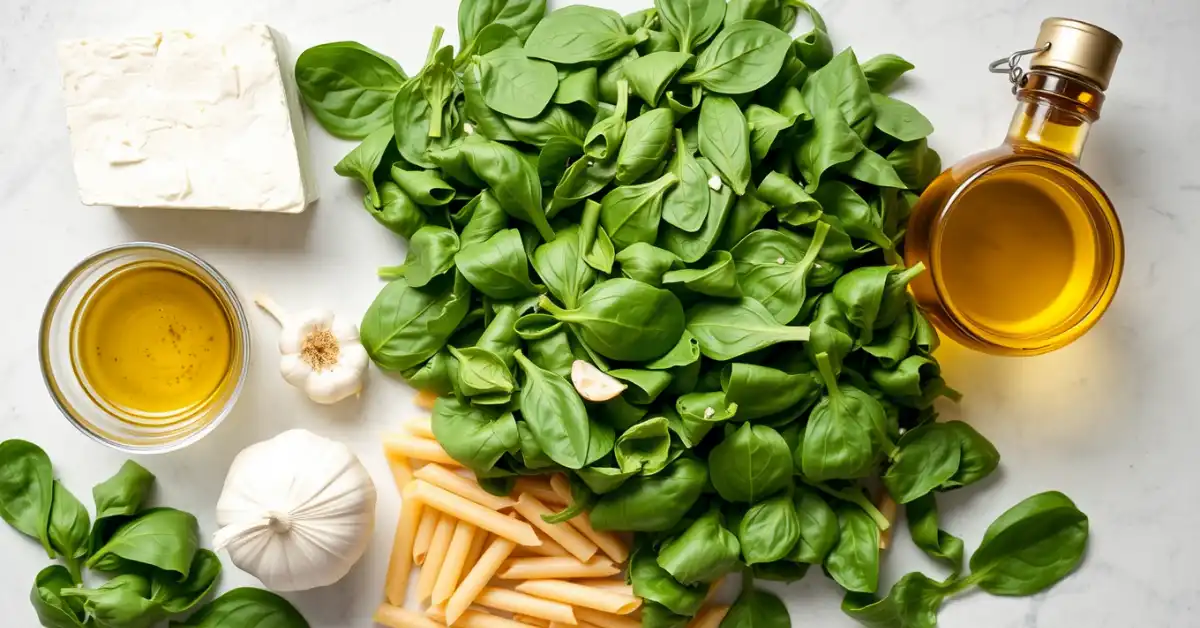
When making spinach and feta pasta, the shape of your pasta really matters. You want a variety that will hold onto the crumbled feta and wilted spinach, soaking in every drop of that olive oil and garlic flavor.
Here are the top pasta shapes that work beautifully in the spinach and feta pasta recipe:
| Pasta Type | Why It Works |
| Penne | Tubes hold cheese crumbles and bits of spinach well. |
| Fusilli | Spirals trap the feta and olive oil beautifully. |
| Farfalle | Great texture contrast with creamy cheese. |
| Spaghetti | Classic, twirls well but best with slightly saucier version. |
If you’re gluten-sensitive, opt for gluten-free lentil or chickpea pasta. These not only work well with feta but add extra protein and a nutty flavor too.
Fresh Spinach vs Frozen: What Works Best
Fresh spinach is always the ideal choice when you’re aiming for bright color and subtle texture. It wilts quickly, retains its earthy flavor, and doesn’t water down the dish.
However, frozen spinach is a solid option if you’re short on prep time. Be sure to defrost and drain any excess water before incorporating it into the pan.. This prevents your pasta sauce from becoming watery and ruining your spinach and feta pasta dish.
Pro Tip:
Use baby spinach for a sweeter, more tender taste and quicker cooking. If using mature spinach, remove the stems and chop it finely.
Block Feta vs Crumbled Feta – Pros and Cons
One of the most asked questions about this recipe is:
““Can I replace block feta with crumbled feta?“
And the answer is: Yes—but with a catch.
| Feta Type | Pros | Cons |
| Block Feta | Creamier, melts better, full flavor | Requires crumbling by hand |
| Crumbled Feta | Convenient, pre-measured | Slightly drier, less creamy |
Block feta cheese usually contains fewer additives and retains moisture better, which results in a smoother, creamier sauce. If you’re aiming for restaurant-quality Mediterranean pasta, block feta is the way to go.
Want to take it further? Try French sheep’s milk feta or even Bulgarian feta for slightly tangier versions.
How to Make Spinach and Feta Pasta Step-by-Step
Quick and Easy Recipe Overview
If there’s one thing to love about spinach and feta pasta, it’s the fact that you can go from zero to Mediterranean dinner hero in under 25 minutes. The ingredients are simple, the process is straightforward, and the result is a creamy, flavorful dish that feels gourmet without the fuss.
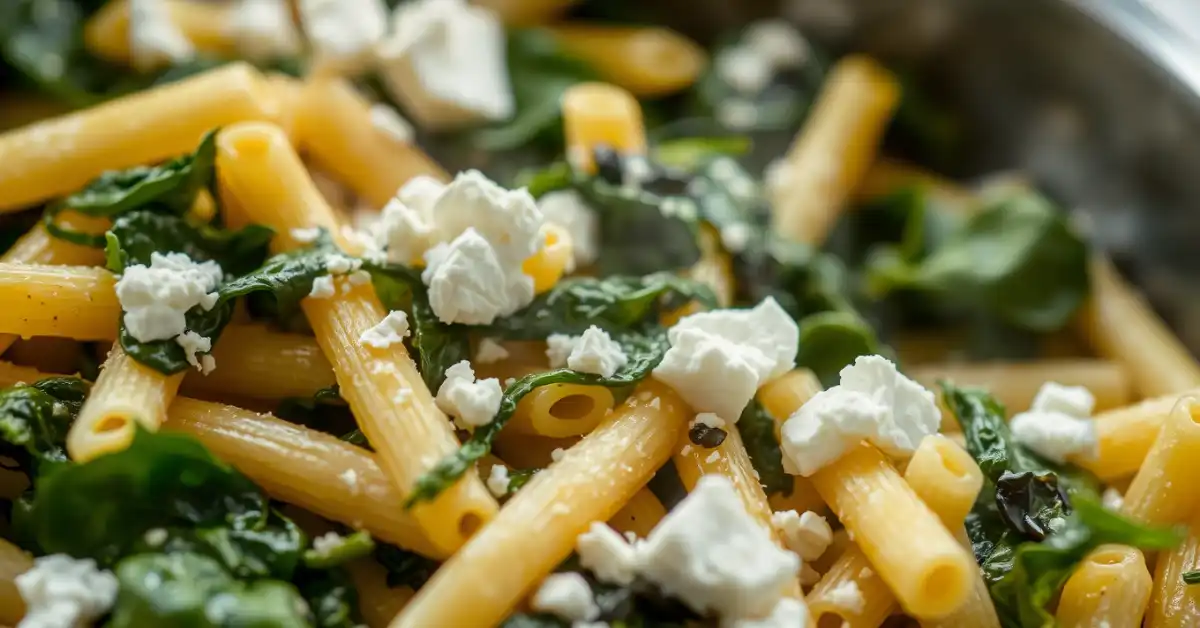
Here’s a quick overview of what you’ll need:
Basic Ingredients:
- Pasta (penne, fusilli, or spaghetti)
- Fresh baby spinach
- Block feta cheese
- Garlic (minced)
- Olive oil (extra virgin)
- Salt and pepper
- Lemon zest (optional but adds brightness)
- Red pepper flakes (optional, for a mild kick)
Cooking the Pasta Perfectly Al Dente
Pour salted water into a large pot and heat it until it reaches a vigorous boil. Don’t skimp on the salt—make it flavorful like the ocean. This is the exclusive moment to enhance the pasta with seasoning.
Cook the pasta until al dente, meaning it still has a bit of bite. For most types like penne or fusilli, this takes 9–11 minutes. Drain, but reserve ½ cup of pasta water—you’ll need it later to emulsify the sauce.
Pro Tip: Never rinse your pasta. The starch helps the feta cling and the sauce come together naturally.
Wilting the Spinach Just Right
In a large sauté pan, heat 2 tablespoons of olive oil over medium heat. Add minced garlic and let it sizzle for 30 seconds—don’t let it brown.
Then toss in your fresh spinach. Stir frequently until it just wilts—no more than 2–3 minutes. Overcooked spinach loses its vibrancy and becomes mushy.
If using frozen spinach, ensure it’s fully drained and cook it for 3–4 minutes until the excess moisture evaporates.
Melting Feta Without Losing Its Character
Now it’s time for the magic: crumble your block of feta cheese right into the pan with the spinach.Carefully stir in a splash of the reserved pasta water to help develop a light and creamy texture.
The feta won’t completely melt—and that’s a good thing. It’ll soften just enough to coat the pasta while keeping its signature crumbly texture.
Add your pasta to the pan and toss everything together. Finish with black pepper, lemon zest, and a drizzle of extra virgin olive oil for brightness. And your spinach and feta pasta dish is ready.
Optional Add-ons:
| Add-In | Effect on Dish |
| Cherry Tomatoes | Adds color, acidity, and freshness |
| Kalamata Olives | Briny boost that enhances feta |
| Crushed Red Pepper | Subtle heat, balances saltiness |
| Toasted Pine Nuts | Crunch and richness |
Don’t miss our Quick Mediterranean Food ideas for easy twists on classic recipes.
Tips and Variations to Customize Your Spinach and Feta Pasta Dish
Adding Cherry Tomatoes, Mushrooms, or Olives
One of the best things about spinach and feta pasta is how flexible it is. You can keep it clean and simple or dress it up for a more gourmet experience. Check out these top ingredients to consider adding:
| Ingredient | Why It Works |
| Cherry Tomatoes | Add a burst of acidity and natural sweetness |
| Sautéed Mushrooms | Give depth and umami, especially with portobello or cremini |
| Kalamata Olives | Intensify the Mediterranean flavors with a briny punch |
| Caramelized Onions | Add sweetness and balance the feta’s saltiness |
| Sun-Dried Tomatoes | Chewy texture + concentrated flavor |
These additions not only enhance flavor but also bring vibrant color to your dish, making it even more appetizing on the plate.
Turning Spinach and Feta Pasta It into a Baked Casserole
Want to take it a step further? Turn your simple stovetop pasta into a baked spinach and feta pasta casserole. Here’s how:
- Preheat your oven to 375°F (190°C).
- After mixing the pasta with spinach and feta, transfer it to a baking dish.
- Add a handful of shredded mozzarella or grated kefalotyri on top for that golden crust.
- Bake for 15–20 minutes, or until bubbly and golden brown on top.
This variation is perfect for meal prepping, potlucks, or even freezing for future dinners.
Making Spinach and Feta Pasta Vegan or Gluten-Free
For a vegan version of spinach and feta pasta:
- Use a vegan feta substitute (almond-based versions work best for creamy results).
- Add nutritional yeast for extra cheesy flavor.
- Swap butter (if used) for extra virgin olive oil.
To make spinach and feta pasta gluten-free:
- Choose gluten-free pasta made from lentils, brown rice, or chickpeas.
- Ensure any pre-packaged feta or seasoning doesn’t contain hidden gluten.
These adjustments let you keep all the bold Mediterranean flavor of spinach and feta pasta while catering to specific dietary needs.
What to Serve with Spinach and Feta Pasta
Salads and Starters that Pair Perfectly
Spinach and feta pasta is a rich, flavorful dish, so the best sides are those that bring brightness, crunch, or contrast. Here are a few refreshing options to start your meal:

| Salad / Starter | Why It Pairs Well |
| Greek Village Salad | Crisp cucumbers, tomatoes, olives, and lemony vinaigrette |
| Arugula and Citrus Salad | Adds peppery freshness and balances salty feta |
| Hummus with Warm Pita | Creamy, garlicky spread with a soft texture contrast |
| Cucumber Yogurt Dip (Tzatziki) | Cool and tangy—perfect for rich pasta pairings |
These starters help awaken the palate and introduce Mediterranean textures—smooth dips, crunchy veggies, and bold herbs.
Mediterranean Side Dishes
To elevate your Spinach and feta pasta plate, pair the pasta with one of these easy-to-make Mediterranean sides:
- Roasted Vegetables – Think zucchini, bell peppers, red onions, and eggplant. Roast in olive oil, garlic, and oregano.
- Stuffed Grape Leaves (Dolmas) – Serve chilled with lemon wedges for a traditional Greek twist.
- Grilled Halloumi – Adds a salty, meaty bite without adding meat.
These sides bring variety and depth to your plate without overpowering the pasta’s flavors.
Light Desserts to Finish the Meal
After a bowl of creamy spinach and feta pasta, end your meal with something sweet but light. Stick to Mediterranean-inspired desserts like:
- Orange Blossom Semolina Cake – Fragrant and not overly sweet.
- Fresh Figs with Honey and Walnuts – Simple yet indulgent.
- Greek Yogurt with Pomegranate Seeds and Pistachios – Rich in texture and flavor.
These desserts cleanse the palate and round out your meal with natural, wholesome ingredients.
Storing, Reheating & Meal Prepping
Best Practices for Storing Spinach and Feta Pasta&Leftovers
Spinach and feta pasta stores surprisingly well, especially if you follow a few simple tricks. Whether you’ve made a double batch or just have some leftovers, here’s how to keep it fresh:
- Storage Container: Use an airtight glass or BPA-free plastic container to avoid moisture build-up.
- Storage Time: Refrigerate for 3 to 4 days.
- No Freezing Recommendation: Avoid freezing, as spinach becomes mushy and feta can turn grainy when thawed.
Also, don’t forget to let the dish cool before sealing it. Trapping steam inside your container can create unwanted sogginess.
How to Reheat Without Losing Texture
The key to delicious reheated pasta is gentle heat. Avoid the microwave unless you’re short on time—use the stove whenever possible.
Reheating on the Stovetop:
- Add a splash of water, broth, or olive oil to a skillet.
- Mix in the cold pasta and heat it slowly over medium-low flames.
- Stir until just heated through, about 3–5 minutes.
Reheating in the Microwave (if necessary):
- Place in a microwave-safe bowl.
- Add a spoonful of water or olive oil.
- Loosely cover and heat in 30-second bursts, stirring in between.
This keeps the feta creamy and prevents the spinach from overcooking.
Making Spinach and Feta Pasta for Weekly Meal Prep
This dish is a meal prep superstar. Not only is it filling and balanced, but it also reheats well and doesn’t rely on heavy sauces that separate over time.
Here’s how to meal prep it effectively:
- Make a double batch and divide into individual containers for the week.
- Keep toppings separate like olives or cherry tomatoes, and add them just before reheating to preserve texture.
- After reheating, enhance the dish with a splash of fresh olive oil and a squeeze of lemon juice for a flavor boost.
You can also repurpose the dish:
- Serve it cold as a Mediterranean pasta salad.
- Toss it with greens for a warm, hearty lunch bowl.
- Add grilled chicken, shrimp, or tofu for a protein-packed twist.
How to Reheat Without Losing Texture
The key to delicious reheated pasta is gentle heat. Avoid the microwave unless you’re short on time—use the stove whenever possible.
Reheating on the Stovetop:
- Add a splash of water, broth, or olive oil to a skillet.
- Toss in the cold pasta and warm over medium-low heat.
- Stir until just heated through, about 3–5 minutes.
Reheating in the Microwave (if necessary):
- Place in a microwave-safe bowl.
- Add a spoonful of water or olive oil.
- Cover loosely and heat in 30-second intervals, stirring between.
This keeps the feta creamy and prevents the spinach from overcooking.
Making Spinach and Feta Pasta for Weekly Meal Prep
This dish is a meal prep superstar. Not only is it filling and balanced, but it also reheats well and doesn’t rely on heavy sauces that separate over time.
Here’s how to meal prep it effectively:
- Make a double batch and divide into individual containers for the week.
- Keep toppings separate like olives or cherry tomatoes, and add them just before reheating to preserve texture.
- Add a fresh drizzle of olive oil and squeeze of lemon juice after reheating for a flavor refresh.
You can also repurpose the dish:
- Serve it cold as a Mediterranean pasta salad.
- Toss it with greens for a warm, hearty lunch bowl.
- Add grilled chicken, shrimp, or tofu for a protein-packed twist.
Nutritional Benefits of Spinach and Feta Pasta
Health Benefits of Spinach
Spinach isn’t just a filler green—it’s a nutrient powerhouse. Whether you’re tossing it into pasta or blending it into smoothies, spinach offers impressive health perks:
| Nutrient | Benefit |
| Iron | Supports healthy red blood cells |
| Magnesium | Aids muscle and nerve function |
| Vitamin A | Boosts eye and skin health |
| Vitamin K1 | Promotes proper blood clotting |
| Fiber | Supports digestion and fullness |
This leafy green is low in calories yet high in antioxidants like lutein and zeaxanthin, which protect the eyes from age-related damage. It also adds volume and vibrancy to your meal, making your plate more filling without extra calories.
Is Feta Cheese Okay for Daily Consumption?
Feta is one of the healthiest cheese options you can choose—especially if you love bold, salty flavor but want to keep fat content in check. A tiny bit of feta can make a significant difference.
Here’s why feta fits into a balanced diet:
- Lower in fat than cheddar or cream-based cheeses
- Rich in calcium and B vitamins
- Contains probiotics for gut health
- Naturally low in carbs
That said, feta is salty by nature. If you’re watching your sodium, you can soak the block in water for 10–15 minutes before using—it’ll dial down the saltiness without affecting its tang.
Spianch and feta pasta: A Balanced, Wholesome Mediterranean Meal
When you put it all together, spinach and feta pasta is more than just tasty—it’s a smart choice for health-conscious eaters:
- Balanced macros: protein, complex carbs, and healthy fats
- Fiber-rich from spinach and whole grain or legume-based pasta
- Naturally vegetarian (and easily adaptable to vegan)
- Packed with flavor, so you need fewer added fats or sauces
It’s exactly the kind of meal the Mediterranean diet champions—fresh, whole, flavorful, and rooted in balance.
FAQs About Spinach and Feta Pasta
Do spinach and feta go together?
Absolutely. Spinach and feta are a classic Mediterranean pairing. The mild earthiness of spinach perfectly complements the salty, tangy profile of feta cheese. Whether used in spanakopita, salads, or pasta, this duo delivers balanced flavor and nutrition.
Does feta go well with pasta?
Yes, feta cheese pairs beautifully with pasta. Unlike melty cheeses, feta softens and creates a creamy, textured coating when mixed with warm pasta. Its bold flavor lifts mild ingredients like spinach, tomatoes, or zucchini.
What vegetables pair well with feta pasta?
Many vegetables complement feta pasta well. Try:
Cherry tomatoes
Zucchini
Bell peppers
Mushrooms
Eggplant
Roasted red peppers
Onions (caramelized or red)
These veggies add color, sweetness, and richness to your dish.
Is it OK to eat feta cheese every day?
In moderation, yes. Feta is lower in fat than many cheeses and is a good source of calcium and probiotics. However, it is high in sodium, so be mindful of portion sizes or rinse it in water to reduce saltiness.
How do Greek people eat feta?
Feta is a staple in Greek cuisine. It’s served in large blocks drizzled with olive oil and oregano, tucked into pastries like spanakopita, or crumbled over Greek salads. It’s also enjoyed alongside olives, bread, and grilled meats.
Conclusion: A Mediterranean Moment in Every Bite
Spinach and feta pasta isn’t just another weekday meal—it’s a dish layered with stories, memories, and culture. It’s a celebration of simple ingredients done right, rooted in the flavors of Morocco, Greece, and the Mediterranean coast.
From quick weeknight dinners to heartwarming lunches with friends, this pasta delivers comfort and sophistication in every forkful. With its creamy feta crumbles, garlicky wilted spinach, and the perfect pasta base, it’s proof that food doesn’t have to be complicated to be deeply satisfying.

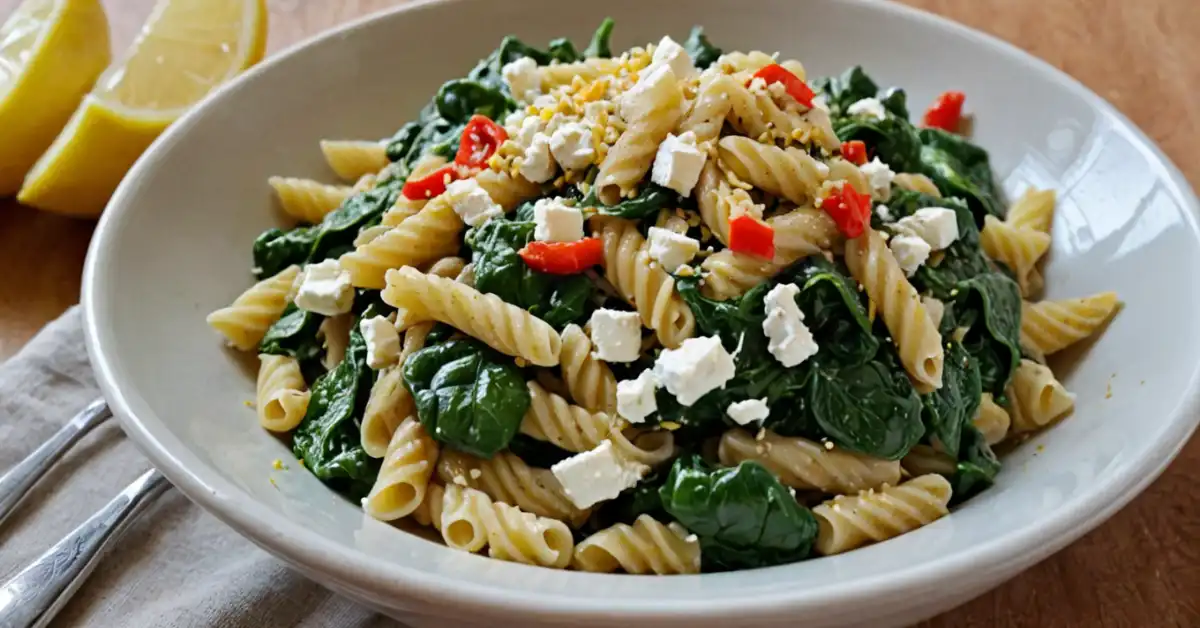
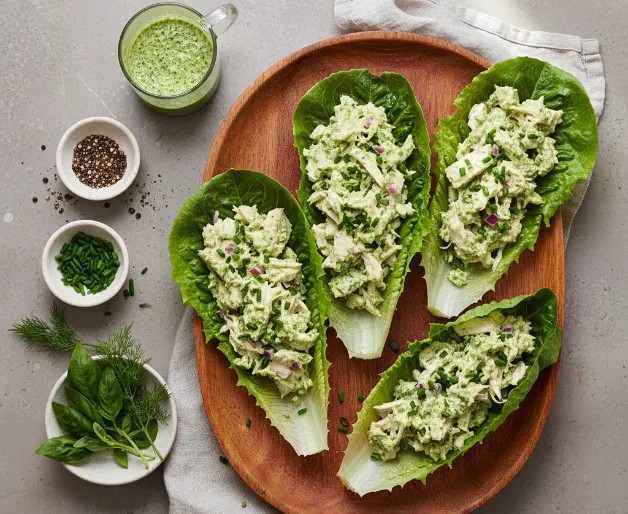
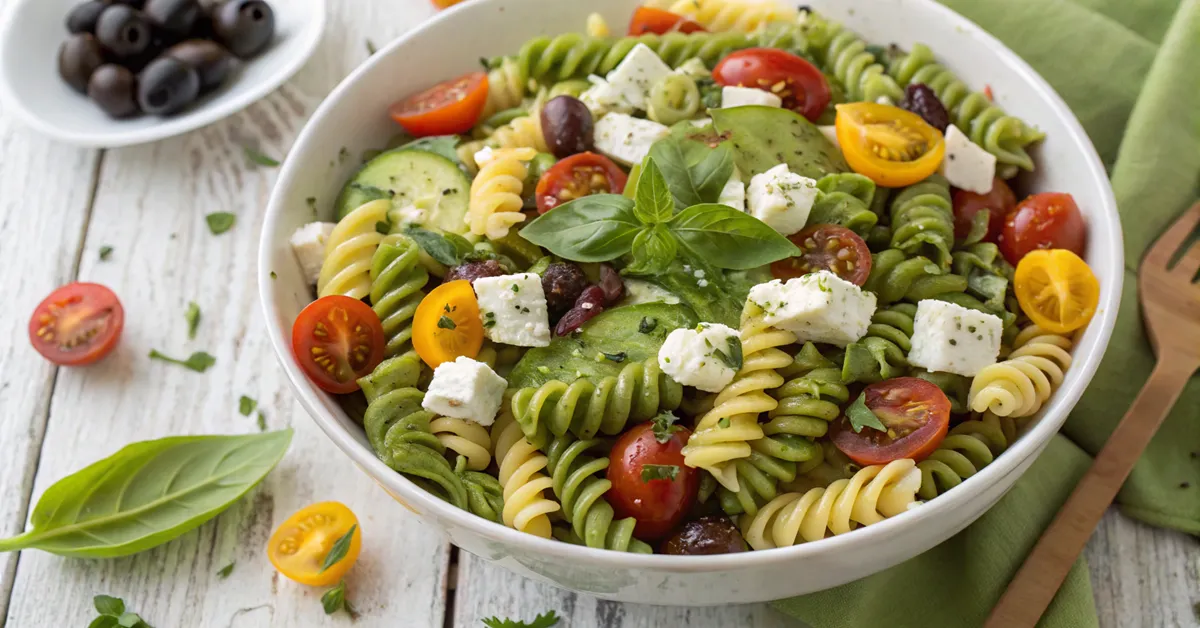

1 thought on “Spinach and Feta Pasta: a Simple Fusion of Flavor and Tradition”